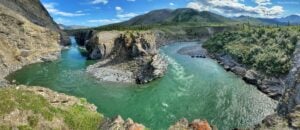
Travel
Travelling through time: Egypt in all its glory
George Kourounis recounts his unforgettable experience travelling through Egypt with Exodus Travels
- 1325 words
- 6 minutes
Travel
Once an enormous coral reef, these magnificent mountains are now one of Italy’s main outdoor attractions

My hands squeeze my trekking poles as I try to keep myself upright while maneuvering down a gorge along the Dürrenstein ridge. The sun is blazing and the limestone below my feet crumbles as I take baby steps down the scree. Our group leader, Rob Mason, is in front, reminding us to keep our feet facing forward and to avoid the temptation to descend on our behinds. But my foot slips, and I skid a few feet, falling on my behind anyway. I’m fine but eager to return to flat ground.
We reach the bottom and immediately face another challenge: a 50-foot trek back up another scree slope. I try not to think about the daunting ascent ahead and instead focus on putting one foot in front of the other. In less than half an hour, we’re back at the top, admiring the incredible peaks all around us. “It’s amazing what you can do when you don’t put your mind to it,” says Martha Parker, one of 13 group members on this Exodus Adventure Travels experience through the Italian Dolomites.
It’s our third day, and the best words I can use to describe this trip are breathtaking, otherworldly and…. rocky. No matter which way you look, you’re surrounded by the sheer cliffs, vertical walls and narrow, deep and long valleys that make up this UNESCO World Heritage Site. But it wasn’t always this way.


Some 250 million years ago, during the Triassic Period, the Dolomites we know today were completely underwater. Tropical coral reefs formed by organisms and sediments dotted the ocean landscape, still evident today in the numerous fossils found throughout the region. “If you’re going up 1,000 metres, you could be going through 50 to 100 million years,” says Mason. “But it’s hard to put a figure on it because you’ll often get big sections that are overturned.”

Growing up in Cornwall, England, Mason was familiar with cliffs. When he later moved to live in the mountains, his interest in geology only grew. “I just wanted to understand how the world works and explain the scenery a bit more,” he says. “I’ve done a few of the classic climbs to the summits around here, and it’s so dramatic so quickly. You can really be up at the top of the world in a couple of hours. It has amazing landscapes.”
Mason explains how geologists view the Dolomites as the classic example of the Triassic Period, starting with the last supercontinent, Gondwanaland. Back when the region was a calm tropical sea, carbonate and limestone could form very quickly before the continent began to break up. “The sea was known as the Tethys,” says Mason. “You start off with a massive volcanic basement rock, which we see when we are hiking around. It’s really obvious in the mountains because all the grass is green, and all the pine trees are bright green because there is loads of water. And as soon as you get out of the basement volcanics, the flora and fauna completely change, and you see the bright white mountains of the Dolomites.”
The Dolomites were originally known as the “pale mountains.” White peaks and ridges form the landscape, creating the otherworldy views that draw so many thousands of adventurers. In the 18th century, a visiting French geologist named Dieudonné Dolomieu realized the rock here was not the same as other limestone. It was brittle and bright white — a Dolomitic limestone. “It’s almost a marble, and it has calcium carbonate, which is usually what makes it limestone,” says Mason. The calcium in the rock has been replaced by magnesium in a process known today as dolomitization, a process that leaves the rock more closely resembling marble over limestone.
When dinosaurs ruled the Earth during the Jurassic Period, sediment accumulated on the seabed, forming a layer of compacted rock, which then turned into solid limestone. Today, fossils abound, including a 220-million-year-old fossilized footprint of a three-toed dinosaur called a therapod.
Since ancient times, fields and pastures have offered up strange rocks holding the remains of ancient reefs and marine sediments. Even at 3,000 metres altitude, fossils can be found shunted up by the alpine orogeny, “The same thing that created the Pyrenees, the Alps and running all the way through towards the Himalaya,” says Mason. He explains how the closing of what was once the Mid-European Ocean has now uplifted rocks, building mountains and pushing fossils to the top of peaks. Fossils, however, are not the only pieces of time that can be found when trekking through the Dolomites.



The flashlight on my phone is not doing me any good. Everything around me is still pitch black as I shuffle through the cold, damp tunnel at the top of Monte Piana on day six of our Exodus Travels adventure. “Big rock!” someone shouts in front of me. “Big rock!” I then yell to the rest of the group behind me while maneuvering around the basketball-sized boulder in the middle of the passage. I am hunched over, trying not to hit my head on the ceiling of this man-made tunnel dug into the side of a 2,325-metre mountain.


Between 1915 and 1917, this area would have been the centre of an important World War I battle between Austria and Italy. Because the border between the Habsburg Monarchy of Austria-Hungary and Italy was placed directly through Monte Piana, it was a strategically important mountain. A bloody trench war lasted for two years here, leaving remnants that include barbed wire, shrapnel and metal sheets marred with bullet holes. The top of Monte Piano/Piana now exists as an Open Air Museum for travellers who come to explore the trenches, tunnels and emplacements.
After just a few moments, there’s light at the end of the tunnel, which was dug in a zig-zag formation to prevent a straight line of fire. At the end, there is just, a 1.5-metre shelf before the mountain drops off into a deep gorge far below.
We make our way up the remaining few metres to the top of the mountain, where crosses have been placed as memorials. Sitting at the summit with breathtaking views of the scenery below, I pull out my packed lunch from Hotel Adler, our base for the duration of the trip. From here, we can see the Austrian Alps in the distance and a postcard-perfect bright blue lake thousands of metres below. I bite into my mini chocolate croissant, pull my hat over my eyes and lie back on my backpack, appreciating the sun and light breeze — a much different experience to what the soldiers would have experienced in those dark days of the war.


It’s the final day, and our perfectly planned itinerary has saved the best for last: the Tre Cime di Lavaredo hike, one of the Dolomites’ most iconic treks. I feel invincible after climbing more than 1,000 metres and looking out over the famous Three Peaks, the symbol of the UNESCO World Heritage Site. High up in the mountains, it’s hard not to feel strong and inspired, surrounded by history, culture and stupendous views. “Mountain places have got cultures hidden away in the high valleys that have been cut off from other ones,” he says. “Like here, where we are in the north of Italy, everyone speaks German, and the food is completely different.”

But mountains, especially the Dolomites, are not invincible.
Today, climate change is causing glaciers to recede, exposing anomalies like Otzi the Iceman and endangering hikers with more avalanches and falling rocks. The disappearance of ice and snow on lower land is obvious to most, but higher up, above 4,000 metres, you reach the zone where it is permanently at freezing and below. But more and more frequently, temperatures are breaking that barrier, causing ice to melt and rocks to fall. And though we appreciate the warmth on this early September day, Mason warns of “we are having one of the hottest spells on record at altitude in the Dolomites.”
He explains how the tops of mountains are frost-shattered, meaning every little crack that’s opened up has had moisture poured into it, which has then frozen. So, although rocks may appear solid, ice holds them together. “When you get these days of continued high temperatures, that breaks up the ice and fossil glaciers melt, bringing down massive landslides.
On July 3, 2022, a serac on the mountain of Marmolada collapsed, killing 11 people and wounding eight. This large-scale collapse occurred after a heat wave which reached 10 degrees C.
To many, mountains appear immortal, massive and unchanging, but they are also delicate ecosystems being drastically changed. “Unfortunately, I think it’s not a particularly rosy future,” says Mason. “But it is still a beautiful place, and at least if you can get to the mountains, you can keep heading up to get away from the heat.”





Are you passionate about Canadian geography?
You can support Canadian Geographic in 3 ways:

Travel
George Kourounis recounts his unforgettable experience travelling through Egypt with Exodus Travels

Travel
Immerse yourself in Viking archaeology and Basque whaling history while taking in Newfoundland’s scenic coastline and incredible geology

Travel
Brian and Dee Keating share their incredible rafting journey in the remote Arctic tundra on a once-in-a-lifetime Canadian Geographic Adventure

Exploration
An excerpt from The Boundless Life: 13 Lessons Learned the Hard Way